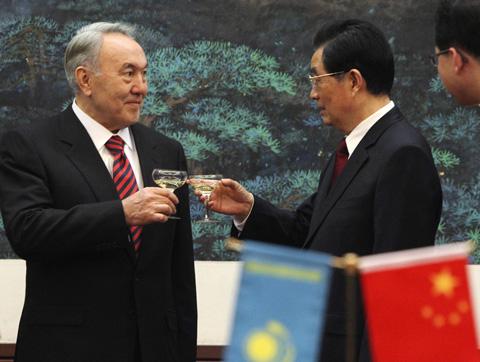
China Seeks Uranium Ore in Kazakhstan
Publication: Eurasia Daily Monitor Volume: 8 Issue: 57
By:

Future prospects for cooperation between China and Kazakhstan were high on the agenda during President Nursultan Nazarbayev’s visit to Beijing on February 21. This overshadowed all other complicated and long-drawn out issues like the water sharing on Ili and Irtysh Rivers, on which a preliminary agreement was reached and the talks on Transborder Rivers, as it was disclosed to journalists, will be finalized during the trip by the Chinese President, Hu Jintao, to Kazakhstan scheduled for June.
Nazarbayev said after his talks with Hu Jintao that Kazakhstan will deliver uranium fuel pellets to Chinese nuclear power plants “worth billions of dollars.” Nazarbayev declared that the joint development of nuclear energy has become much more promising and economically beneficial than cooperation on oil and gas (Strana i Mir, February 24).
Underdeveloped energy infrastructure and strong dependence on imports for electricity from Kyrgyzstan and gas from Turkmenistan to supply its southern regions forces Kazakhstan to look for alternative sources of energy. In April 2010, the atomic energy committee of Kazakhstan’s ministry of industry and new technologies worked out a new draft law on the use of nuclear energy. However, the bill intended to eliminate bureaucratic hurdles on the planned construction of nuclear power plants in Aktau seaport city (Western Kazakhstan or, as a possible alternative, in Kurchatov in Eastern Kazakhstan region) although endorsed by the government, has remained deadlocked in parliament.
In November 2010, the ministry of industry and new technologies announced that a Kazakh-Russian joint venture company was conducting a technical feasibility study of the nuclear power plant to be built in Aktau by the year 2020. But in Kazakhstan there has been a backlash in public opinion against the project because of the public reaction to the radiation leaks at Japanese nuclear reactors damaged by the severe earthquake and tsunami. Several years ago the public opposed government plans to dump foreign nuclear waste in Kazakhstan, and under such pressure the authorities, abandoned the plan, albeit temporarily.
Nevertheless, Duisenbay Turganov, Deputy Minister of Industry and New Technologies, reaffirmed the intention of the ministry to secure an endorsement from the presidential administration for the draft law on nuclear energy. Turganov said the disaster at the Japanese nuclear plants should not deter Kazakhstan from using its rich uranium deposits, the second largest in the world, for its own nuclear energy requirements rather than exporting uranium to a foreign country (Panorama, March 18).
With unreliable supplies from Kyrgyzstan and rising tariffs Kazakhstan cannot entirely rely on electricity imports. This year, Kazakhstan will invest more than 130 billion tenge ($890.89 million) in electricity energy projects, an impressive increase from last year’s investment of 85 billion tenge ($582.5 million). Yet, given the notorious mismanagement and high corruption level, this massive figure will hardly change the situation. The Kazakh parliament adopted a law several years ago on renewable sources of energy, but in fact only 0.5 percent of electricity comes from renewable sources.
Although the temptation to produce cheap nuclear energy in the uranium-rich country is too great to resist, even the ministry of industry and new technologies cannot ignore the fact that Kazakhstan lacks nuclear safety standards and nuclear waste storage facilities and qualified specialists in this field. For technical maintenance of the existing traditional power generators, Kazakhstan depends heavily on foreign investment. Key hydroelectric and coal-fired power stations such as Shulbinskaya, Ustkamenogorskaya and Sorginskaya in Eastern Kazakhstan are owned by the United States’ AES energy corporation. Although the contract between the Kazakh government and AES was signed in 1997, for the past 13 years investment obligations for the corporation largely remained unfulfilled. The AES recently had to sub-contract a Chinese TCC company to carry out the modernization of the Sorginskaya power plant, which needs a total investment of 5.5 billion tenge ($37.69 million). The Chinese promised to complete the work by 2012 (Panorama, March 18).
The current phase of nuclear energy cooperation between Kazakhstan and China can be regarded as part of the long-term Chinese strategy to gain a firm foothold in Kazakhstan’s energy market. According to official sources, Chinese participation in Kazakhstan’s oil and gas sector accounts for 26 percent of the total foreign investment. Kazakhstan and China are actively working on the construction of a gas pipeline running from Kenkyak fields in Western Kazakhstan to the Chinese border at Alashankou. China generously offered large investments for the construction of Moinak hydroelectric power station on Charyn River.
In April 2009, both countries announced the creation of the Semizbay-U joint venture to develop the Irkol mines with an annual output capacity of 750 tons of uranium to be extracted by underground leaching. According to the agreement, concluded between Kazatomprom and China Guangdong Nuclear Power Company, the latter will use the rich deposits for 25 years. What Kazakhstan will gain from nuclear cooperation with China would be technical expertise in the construction of nuclear power plants. Similar assistance was also offered to Kazakhstan by Russia.




